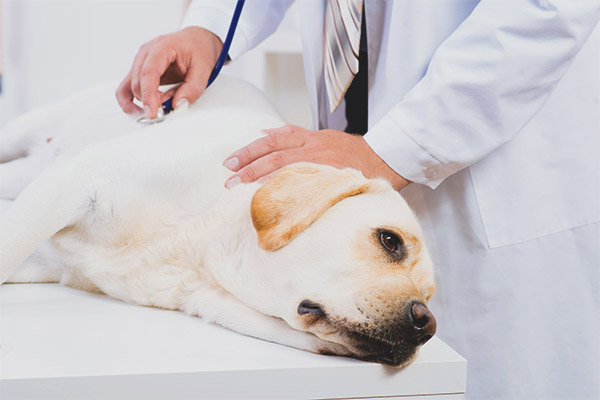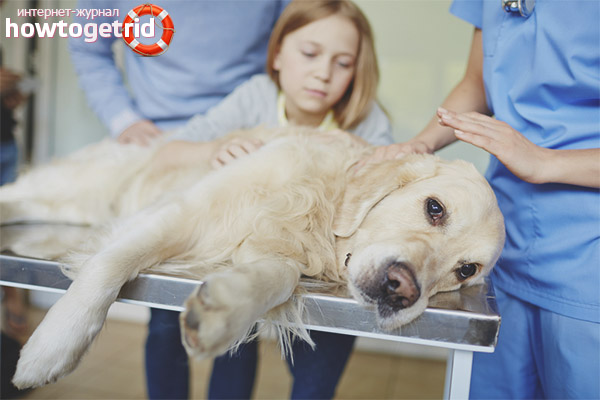The content of the article
Most curious animals can scour in various lanes, bushes, dumps, setting a goal, small game, an insect or a plant. Some of these situations lead to the fact that the dog can be poisoned by something that contained rat poison. This incident is very serious, but rather rare, since the poison is almost always masked unattractively to the animal, for example, in the bodies of poisoned rats. The effect of a toxic substance on a pet's body is possible only by using a fairly large dose. According to statistics, the number of people who applied to veterinary clinics to assist an animal poisoned by rat bait did not exceed 0.1% of all visits to veterinarians.
The increased risk that an animal can eat a poisoned bait occurs when meat products are used for poisoning with poison, which can equally attract both rodents that are going to be exterminated and a pet. If a pet has eaten one carcass of a dead animal infected with rat poison, this may not affect its general well-being. To get a serious toxin infection, it is necessary to devour at least three or four carcasses of rodents killed by the poison.
How does rat poison on the animal
The use of rat poison is intended solely for destroying an invasion of pests such as mice or rats. This substance is added to special baits for rodents, the basis for which, in most cases, the grain is taken. In addition, in the modern market there have long been varieties of baits with the content of rat poison in the form of ready-made briquettes, pastes or pellets.
Rat poison, or as it is also called, rodenticide, is divided into two categories: substances with an acute effect and substances with a chronic effect.You can freely buy only rat poison of chronic action, as it represents a lesser danger, both for man and for animal.
There are several main ways to get into the body of animal rat poison. This can occur due to the fact that the dog eats several dead carcasses of infected mice or rats, or if any meat product that can attract a pet by smell is used as bait for rodents. Of course, the direct entry of a toxic substance into the body is much more serious and affects the general condition of the animal faster than it happens because of the absorption of a dead, poisoned rodent. It should be noted that recently manufacturers of poison for rodents have begun to include in the composition of poisons special aromatic additives with the smell of meat, since it can lure pests fairly well. Accordingly, the same smell may be of interest to the pet, which will lead to the absorption of rat poison in its purest form. And this is more dangerous for the dog.
For the occurrence of a serious reaction, which can pose a real threat to the life of the animal, it is necessary to get into the body of a fairly large amount of this poison, which is a priori impossible.In the amount that can accidentally enter the body, only mild or moderate degrees of poisoning can occur.
Depending on what kind of toxic drug entered the animal, the process of its influence on the organs of the poisoned pet occurs. However, when detecting the first signs, it is necessary to urgently provide first aid to the dog.
Poisonous substances are divided into the following types:
- Rodenticide of the first generation, which is contained in such preparations for pest control as: isopropylfenacin, warfarin, triphenacin and others. It is these toxic drugs most often added to the bait for rodents. When any of them enters the body and begins to spread through the circulatory system of the animal, there is a violation of the synthesis of vitamin K, which is responsible for blood clotting. As a result, there are significant internal hemorrhages, which lead to a large loss of blood of the infected, if they are not promptly removed from the body. Usually the excretion of such toxic drugs is carried out naturally.Of all the poisons that belong to this group of rodenticides, the greatest sensitivity and susceptibility in dogs is observed to warfarin - a critical dose of the drug, which can lead to fatal consequences, is 6 mg per 1 kg of animal weight.
- The second generation rodenticide is preferably found in bromadiolone, flocoumafene and brodifacum. The toxin of this group affects the body of the animal almost as much as the toxin of the first generation, but its difference lies in the fact that it is characterized by accumulative properties. Consequently, the removal of the drug with the content of this toxin is much more difficult. Also, unlike the first generation, the lethal dose of drugs belonging to the second generation will be much lower due to the high concentration of toxins. As you know, the critical dose of brodifacum is 4 mg per 1 kg of animal weight.
- Rat is more dangerous than rodenticides, since its toxicity is several times higher than that of previous substances. In addition, it has a slightly different effect on the body during the period of infection.In addition, its distribution manifests itself much faster. This poison causes convulsions, pulmonary edema, and impaired heart function.
The danger of poisoning with such a toxic substance as rat poison is that any manifestation of symptoms does not start immediately, but only after three to four days. This is due to the fact that in the body of an infected there is a content of a certain amount of vitamin K, and when it is exhausted, signs of poisoning begin to appear. Such a long stay of the toxin in the body can be very dangerous and cause serious damage to the health of the animal.
Signs of poison in the body
There are several common symptoms that are a clear indication that an animal has been poisoned by rat poison and contains a large amount of toxic substances in its body:
- a sharp increase in pet's body temperature;
- the appearance of blood discharge from the anus;
- complete and severe loss of appetite;
- strong weakness and weakness.
If at least one of the listed symptoms is found in an animal, it must immediately provide first aid.
Depending on which type of toxin affects the body, in addition to the main symptoms, others may appear, such as difficulty breathing or bleeding from the nose or mouth. If the degree of poisoning is severe, then in addition to the listed symptoms, severe bleeding from various openings, vomiting of blood, and even partial paralysis are added.
First aid for poisoning an animal with rat poison
If you detect symptoms of infection with an animal with rat poison, it must be immediately transported to a veterinary clinic, where a qualified specialist can provide assistance, determine what substance the poisoning occurred and prescribe the appropriate treatment.
Before the dog gets to the vet, it is necessary to provide first aid in the form of:
- Provocating a gag reflex, which can be caused by putting a tablespoon of common salt in the root of an animal's tongue.
- Washing the stomach of a poisoned pet, which can be accomplished through the use of a warm water enema, it is quite possible to replace water with manganese for disinfection.
- Introducing animal absorbing drugs into the body of the animal, for example, feed with activated charcoal.
Also, the dog must provide abundant drinking, which will contribute to the purification and early elimination of toxic substances from the body. For otpaivaniya recommended to make decoctions of flax seeds, or replace hercules or rice decoction.
It is very important to know that if more than four hours have passed since the dog absorbed rat poison, provoking the gag reflex is useless, because during this time the poison has time to move directly into the intestine. In addition, you can not allow the consumption of dairy and dairy products, as they allow the toxic substance to be absorbed faster in the blood.
Antidote for poisoning
In case of poisoning the animal with rat poison containing an anticoagulant, vitamin K1 intake can help. It occurs under the supervision of a veterinarian in a clinical setting through injective administration of the vitamin into the animal's body. When intoxication provokes a rat, the dog must be otpaivat special solution with a one-percent tannin content.And when poisoning poison containing zinc phosphide - the animal is sealed with a solution containing copper sulphate.
Treatment of the effects of poisoning
When it is not possible to establish a specific toxin that has entered the dog's body, a general treatment course is prescribed in the form of vitamin K1 administration for 7-10 days, glucose injection and various cardiac and diuretic drugs. The procedure of blood and plasma transfusion can also be carried out in order to restore the level of red blood cells in the blood, and resume the process of its clotting.
If the intoxication of the animal's organism was severe, first of all, the treatment of symptoms is carried out, the hepatic functionality is restored, preparations are prescribed to restore the normal functioning of the heart, and also pulmonary edema is removed.
Video: first aid to a dog in case of poisoning












To send